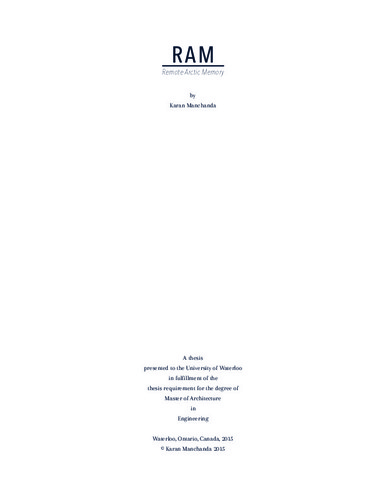| dc.description.abstract | The modern world is defined by networks. One network, specifically, has become the core component in how our societies function; the Internet. While the Internet may seem ubiquitous, seamless, and imperceptible, it is only made possible through physical connections – hundreds of cables running through our oceans unseen by the user. Fibre-optic undersea cables are the backbone of our age, joining together continents and their cities through a hidden network.
This infrastructure of fibre-optic Internet has been scheduled to make its way through the Canadian Arctic Archipelago via the fabled Northwest Passage, in order to connect the cities of London and Tokyo to facilitate faster financial trading. However, this long distance connection does not consider many other users. In its current projection, the “Arctic Fibre” cable will only serve a handful of settlements on the Canadian Arctic coast, with the rest of the coastal settlements remaining connected only through high-cost, low-bandwidth satellite technologies. Excluded, these communities will inevitably be further from the advances of the modern world.
There remains an opportunity to expand the use of this cable network by reaching out and connecting to these remote settlements, creating a greater purpose beyond its narrow mandate to shave milli-seconds off trading systems. An improved connective network in Canada’s Arctic Archipelago is necessary to provide better healthcare, educate through remote access technologies, create efficient communications frameworks for emergency situations and most importantly, give equal access to inhabitants of the Canadian Arctic for an improved quality of life. Specifically, the relationship found between this enabled connectivity, the needs and work of Arctic researchers, and the unique cultures of the regions’ Indigenous communities are of particular interest.
The Canadian Arctic Archipelago is a key site in understanding the consequences of climate change on the environment. However, the vastness of the Canadian Arctic, the lack of a fast and reliable Internet connection, distant communication and data, at times non-existent research infrastructure, and the cultural barrier between researchers and the Indigenous population all contribute to the problems of research in this region. There must be a way to create access to these technologies in remote territories, while respecting the existing cultures, rituals, needs of the Arctic landscapes, and restrictive resources to provide for both Arctic researchers and the Indigenous communities. Indigenous knowledge is now a key resource for understanding how climate change is progressing. If this knowledge is partnered with modern science methodologies through innovative technology networks, there is the possibility for greater and more accessible study into the global environmental future.
For these reasons Remote Arctic Memory [RAM] was envisioned. In developing a design proposal for a connected Arctic condition, this thesis investigates coupling communications and research infrastructure together to create a flexible and scalable connective network for the North. The proposal describes a “New North”, an Arctic networked through a series of occupiable, intelligent monitoring towers deployed across the North to foster gathering of data and sharing of knowledge between researchers and the indigenous communities. This thesis aims to investigate the possibilities and benefits found through architecture, technology and advancing networks collaborating together to connect the Arctic frontier. | en |

